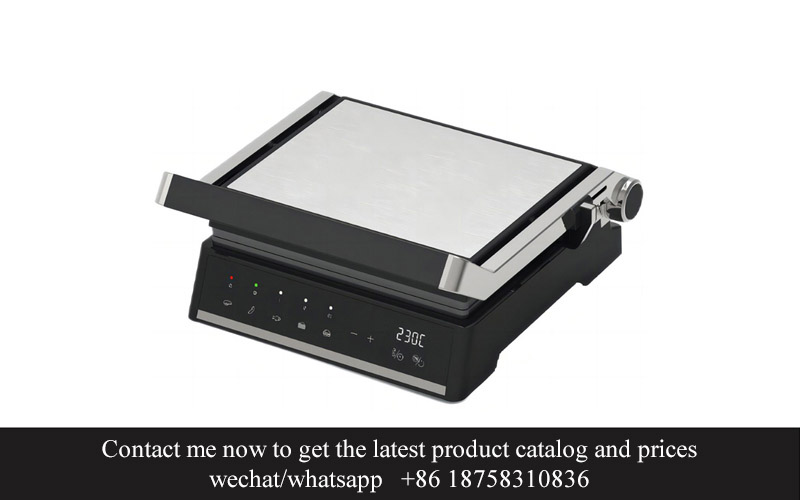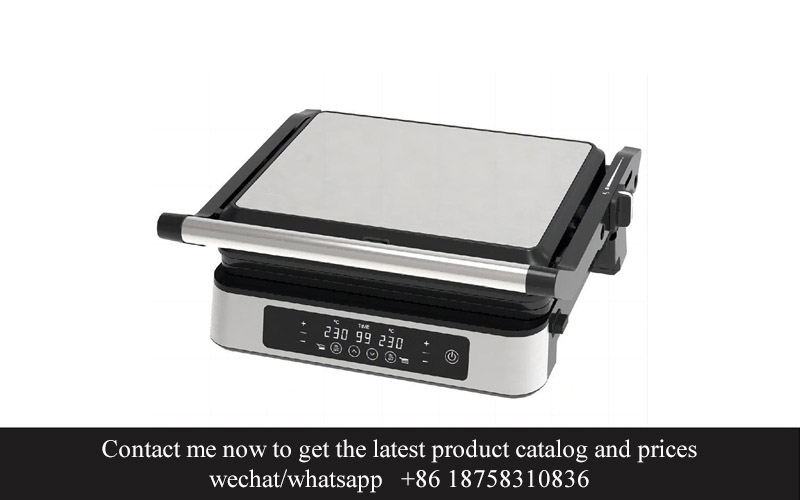Address
304 North Cardinal
St. Dorchester Center, MA 02124
Work Hours
Monday to Friday: 7AM - 7PM
Weekend: 10AM - 5PM
Address
304 North Cardinal
St. Dorchester Center, MA 02124
Work Hours
Monday to Friday: 7AM - 7PM
Weekend: 10AM - 5PM

As the world continues to evolve, so too does the technology around us. One such realm that has seen incredible advancements is the grill industry. What started as a simple outdoor cooking method has transformed into a sophisticated market filled with innovative designs and cutting-edge technology. In this brief overview, we delve into the intricate details of the grill industry’s evolution, highlighting key developments and the transformative impact of modern innovations.
The grill industry has undergone a remarkable transformation over the years, evolving from a simple outdoor cooking method to a sophisticated culinary tool that now graces kitchens around the world. From the humble charcoal grill to the sleek gas-powered models, the evolution of the grill industry reflects not just changes in technology but also shifts in consumer preferences and cultural trends.
In the early days, grilling was a straightforward affair, often involving a simple metal grate over a fire. These primitive grills were often homemade or bought from local blacksmiths, and their designs were limited by the materials and craftsmanship available. The focus was on functionality and durability, with little thought given to aesthetics or convenience.
As the 20th century progressed, the grill industry began to see more innovation. The advent of the Weber grill, introduced in the 1950s, marked a significant shift. George Stephen, the founder of Weber, designed a grill with a lid that allowed for indirect cooking, which was a novel concept at the time. This innovation not only expanded the range of dishes that could be prepared on a grill but also helped to popularize the idea of grilling as a year-round cooking method.
The introduction of gas grills in the 1970s brought about another wave of change. Gas grills offered quicker heat-up times and more consistent temperatures compared to charcoal grills, making them a favorite among busy homeowners. The rise of the gas grill coincided with a growing interest in outdoor living and entertaining, as people sought ways to bring the kitchen experience outside.
With the rise of the gas grill, manufacturers began to focus on design and features that would appeal to consumers looking for more than just a cooking tool. Built-in tables, side burners, and various temperature zones became standard features, turning the grill into a multifunctional appliance. The industry also saw the emergence of electric grills, which were ideal for indoor use or in areas where outdoor grilling was not allowed.
In recent years, the grill industry has been influenced by a variety of factors, including health consciousness, environmental concerns, and technological advancements. Consumers are increasingly interested in grills that offer healthier cooking options, such as infrared or induction cooking surfaces that reduce smoke and char. Eco-friendly materials and energy-efficient designs are also becoming more popular.
The use of in-house mold making has played a pivotal role in this evolution. Custom molds allow manufacturers to create parts that are precisely tailored to their specific needs, enabling them to produce grills with unique features and improved functionality. For example, molds can be used to create intricate designs in the grill’s exterior, enhancing its aesthetic appeal, or to produce parts that enhance the grill’s cooking performance, such as specialized heat shields or precise temperature control mechanisms.
Moreover, the ability to quickly prototype and test new designs using mold-making technology has accelerated the pace of innovation in the grill industry. Companies can bring new products to market faster, responding to consumer demands and market trends more effectively.
Cultural influences have also shaped the grill industry. The popularity of international cuisines has led to a demand for grills that can handle a wider variety of cooking techniques. This has spurred the development of grills with adjustable heat zones, rotisseries, and even smoking capabilities.
The rise of social media and online communities has also had a significant impact. Consumers are more informed and engaged than ever before, and they are quick to share their experiences and preferences. This has created a feedback loop that drives continuous improvement in grill design and features.
In summary, the evolution of the grill industry has been a story of adaptation and innovation. From the simple charcoal grill to the high-tech, multifunctional appliances of today, grills have become an integral part of modern cooking and socializing. As the industry continues to evolve, it will be fascinating to see what new ideas and technologies will shape the future of grilling.

In the ever-evolving world of grill manufacturing, the role of in-house mold making has become increasingly pivotal. This process, often overlooked, plays a critical part in shaping the design, functionality, and overall quality of the grills we use in our kitchens. Let’s delve into the intricacies of in-house mold making and its significance in the grill industry.
The precision of in-house mold making is unparalleled. When it comes to manufacturing grill components, the accuracy of the molds used is paramount. These molds are the blueprints for the parts that make up the grill, from the cooking grates to the handles and hinges. The precision achieved through in-house mold making ensures that each component fits perfectly, which is essential for both the aesthetics and performance of the grill.
Customization is king in the grill market. With consumers increasingly seeking unique and personalized products, in-house mold making allows manufacturers to create custom molds that cater to specific design requirements. Whether it’s a unique handle shape, a distinctive grate design, or a specialized ventilation system, in-house capabilities enable manufacturers to produce grills that stand out in a crowded market.
Efficiency is a byproduct of in-house mold making. When molds are created and maintained within the same facility, it streamlines the production process. Quick turnaround times for mold changes and repairs mean that manufacturers can respond swiftly to market demands and production line needs. This agility is particularly valuable in an industry where trends can shift rapidly.
The cost-effectiveness of in-house mold making cannot be overstated. While it requires an initial investment in equipment and skilled technicians, the long-term savings are substantial. By eliminating the need to outsource mold making, companies reduce transportation costs, improve communication, and maintain quality control over the entire process. This direct control over the mold-making process is a significant advantage in the competitive grill market.
Quality assurance is enhanced through in-house mold making. With the ability to create and refine molds on-site, manufacturers can ensure that the end product meets their exacting standards. This means that the components produced are not only precise but also durable, which is crucial for the longevity of the grill and the satisfaction of the consumer.
Innovation is fostered when mold making is in-house. The close proximity of design teams to the mold-making process encourages creative problem-solving and the exploration of new ideas. This collaboration can lead to the development of cutting-edge grill features that might not have been possible otherwise. From ergonomic designs to smart technology integration, in-house mold making opens doors to innovation.
The environmental impact of manufacturing processes is a growing concern. In-house mold making offers a more sustainable approach. By reducing the need for shipping molds and parts, manufacturers can minimize their carbon footprint. Additionally, the ability to create molds that are optimized for efficiency and durability can lead to less waste and a more sustainable product lifecycle.
The integration of advanced materials is another area where in-house mold making excels. As grill manufacturers look to incorporate high-performance materials like advanced alloys and composites, the ability to create molds that can handle these materials with precision is essential. This integration not only improves the performance of the grill but also opens up new possibilities for design and functionality.
The scalability of in-house mold making is a key factor for grill manufacturers. Whether scaling up production for a major launch or downsizing for a niche market, having the ability to modify molds in-house allows for flexibility. This adaptability ensures that manufacturers can meet changing market demands without disrupting their production flow.
The competitive advantage gained through in-house mold making is substantial. By controlling the entire mold-making process, manufacturers can differentiate their products in a crowded market. This control over quality, design, and efficiency can lead to higher customer satisfaction and stronger brand loyalty.
In conclusion, the role of in-house mold making in the grill industry is multifaceted. It enhances precision, allows for customization, improves efficiency, and fosters innovation. The cost savings, quality assurance, environmental benefits, material integration, scalability, and competitive edge it provides are just a few reasons why in-house mold making has become an integral part of the grill manufacturing process. As the industry continues to evolve, the importance of in-house mold making is only expected to grow, driving the next wave of innovation in grill design and technology.

In the world of manufacturing, custom molded parts have emerged as a game-changer, offering a multitude of benefits that can significantly impact the quality, efficiency, and overall success of products. Here’s a closer look at some of the key advantages of utilizing custom molded parts:
Enhanced Design FlexibilityCustom molded parts allow for unparalleled design freedom. Unlike standard parts that may have limitations in shape, size, or material, custom molding can create intricate and complex geometries that perfectly match the specific requirements of a product. This flexibility means manufacturers can bring their most imaginative designs to life, often resulting in products that stand out in the market.
Improved PerformanceThe precision of custom molding ensures that parts fit together seamlessly, reducing the risk of gaps, leaks, or other performance issues. This tight fit contributes to a more efficient and reliable product, which is crucial in industries where performance is paramount, such as automotive, aerospace, and medical devices.
Cost-Effective ProductionWhile custom molded parts may seem expensive at first glance, they can actually be more cost-effective over time. By using a single mold to produce multiple parts, manufacturers can achieve high-volume production with lower per-unit costs. Additionally, the ability to design parts with fewer components can simplify assembly and reduce material waste.
Material SelectionCustom molding allows for the use of a wide range of materials, from plastics and rubbers to metals and ceramics. This versatility means that designers can choose the perfect material for their application, optimizing properties like strength, durability, flexibility, and thermal resistance. The right material can enhance the lifespan of a product and reduce maintenance costs.
Reduced Lead TimesWith in-house mold making capabilities, manufacturers can significantly reduce lead times. By eliminating the need for external suppliers, they can expedite the design, prototyping, and production processes. This agility is particularly valuable in industries with tight deadlines or where quick response to market demands is crucial.
Enhanced Product QualityThe consistency and precision of custom molded parts contribute to higher overall product quality. Each part is produced to exact specifications, which minimizes the risk of defects and ensures that the final product meets or exceeds customer expectations. This attention to detail can also lead to better customer satisfaction and brand reputation.
Intellectual Property ProtectionCustom molded parts are unique to each product, which can provide a competitive edge by protecting intellectual property. When a part is designed specifically for a product, it becomes difficult for competitors to replicate, helping to maintain a unique selling proposition.
Environmental ImpactCustom molding can also be more environmentally friendly. By optimizing part designs and using materials efficiently, manufacturers can reduce waste and energy consumption. Additionally, certain materials used in custom molding can be recycled, further reducing the environmental footprint.
Customization for Specific ApplicationsIn many industries, products need to be tailored to specific applications or environments. Custom molded parts can be designed to withstand extreme temperatures, chemicals, or mechanical stress, making them ideal for specialized equipment or components that require unique properties.
Streamlined Supply ChainWhen parts are molded in-house, manufacturers can better control the supply chain. This can lead to more consistent quality, improved inventory management, and the ability to respond quickly to changes in demand or production issues.
In summary, the benefits of custom molded parts are numerous, from design flexibility and performance improvements to cost savings and environmental benefits. As technology continues to advance, the importance of custom molding in the manufacturing process is only expected to grow, offering even more advantages to companies looking to innovate and succeed in their respective markets.

Grill design has come a long way from the simple outdoor cookers of yesteryears. Today, the market is brimming with innovative and sophisticated designs that cater to a wide range of tastes and preferences. Here are some of the key innovations that have shaped the grill industry:
Integrated Cooking SystemsModern grills are no longer just about cooking meat. Innovations in design have led to integrated systems that can handle a variety of cooking methods, including grilling, smoking, roasting, and even baking. These multi-functional grills offer versatility that allows users to prepare a wide array of dishes with a single appliance.
Smart Technology IntegrationThe fusion of grill design with smart technology has brought a new level of convenience and control to grilling. Grills equipped with digital thermometers, Bluetooth connectivity, and app-controlled settings allow users to monitor and adjust their grilling process from a distance. This level of technology ensures that food is cooked to perfection every time.
Eco-Friendly MaterialsEnvironmental consciousness has become a significant factor in grill design. Manufacturers are now using sustainable materials like recycled stainless steel, BPA-free plastics, and eco-friendly woods for the construction of grill grates and other components. These materials not only contribute to a greener planet but also offer durability and heat retention.
Enhanced Heat DistributionOne of the biggest challenges in traditional grill design has been heat distribution. Innovators have tackled this issue by introducing technology like ceramic briquettes, infrared heating elements, and advanced convection systems. These advancements ensure even heat distribution, reducing the risk of hotspots and improving cooking efficiency.
Space-Saving and Compact DesignsAs urban living spaces become more compact, grill manufacturers have responded with space-saving designs. Portable grills, foldable models, and compact countertop units have made it possible for city dwellers to enjoy the joys of grilling without taking up a lot of space. These innovative designs often come with integrated storage solutions for tools and accessories.
Customizable and Modular ComponentsToday’s grills offer more customization options than ever before. Users can choose from various grill sizes, grate configurations, and add-ons like side burners, rotisseries, and warming racks. Modular designs allow for easy upgrades and the ability to tailor the grill to specific cooking needs.
Aesthetic ImprovementsGrill design has also evolved to cater to aesthetic preferences. Sleek, modern designs with clean lines and premium finishes are now commonplace. Many grills come in a variety of colors and materials, from classic stainless steel to bold, patterned stone or wood-grain finishes.
Enhanced Safety FeaturesSafety has always been a concern in grill design, and recent innovations have brought about significant improvements. Features like cool-to-the-touch handles, automatic shut-off systems, and built-in gas leak detectors provide peace of mind for users. Additionally, grill manufacturers are incorporating child safety locks and barriers to prevent accidents.
User Experience and ConvenienceGrill design is increasingly focused on the user experience. Innovative features like easy-to-clean surfaces, removable ash trays, and easy-access storage compartments make maintenance and use more convenient. Some models even come with LED lighting for grilling in the dark or for added ambiance.
Performance EnhancementsFinally, grill design innovations are continuously pushing the boundaries of performance. From high-efficiency burners that provide more heat with less gas to advanced temperature control systems, these advancements ensure that grilling is not only more enjoyable but also more efficient and effective.
These innovations in grill design reflect the ever-growing demand for functionality, convenience, and aesthetic appeal. As the grill industry continues to evolve, we can expect to see even more creative and cutting-edge designs that transform the way we enjoy outdoor cooking.

In the realm of grill manufacturing, there are several remarkable case studies that showcase the successful implementation of innovative strategies and technologies. These stories highlight how companies have navigated challenges, embraced change, and ultimately achieved success through their forward-thinking approaches. Here are a few such examples:
The integration of advanced materials in grill construction has been a game-changer for several brands. One such brand, GrillGuru, shifted from traditional steel to lightweight, durable, and heat-resistant materials like titanium and aluminum alloys. This change not only improved the grill’s lifespan but also reduced the overall weight, making it easier for consumers to transport and use.
Another case study involves a company that specialized in smart grill technology. GrillTech, known for its high-tech grills, successfully implemented a line of models equipped with IoT capabilities. This allowed users to control their grills remotely via a smartphone app, providing convenience and enhancing the cooking experience with features like temperature control and smart notifications.
In the world of outdoor grilling, the aesthetic appeal of a grill can be just as important as its functionality. One brand, EcoGrill, focused on sustainable materials and design. They developed a line of grills made from recycled materials, offering a stylish and eco-friendly alternative. The unique design caught the attention of environmentally conscious consumers, leading to a significant increase in sales.
Customization has also played a pivotal role in grill design. CustomGrill, a leader in personalized cooking solutions, implemented a 3D printing technology that allowed customers to design their own grill grates. This innovative approach not only provided customers with a unique product but also opened up new revenue streams through personalized sales and customization services.
Safety is a top priority in the grill industry, and one company, SafeGrill, made headlines with their innovative fire-resistant grill cover. This cover, developed through extensive research and testing, significantly reduced the risk of fire due to sparks from the grill. The implementation of this product led to a surge in sales and a reputation for safety among grill enthusiasts.
The integration of health-conscious features has been another successful implementation. HealthGrill introduced a range of grills with built-in air filters and smoke management systems. These features helped reduce the amount of smoke and harmful emissions, making grilling a healthier option for both the user and the environment.
For those who enjoy outdoor cooking, the need for versatility is paramount. VersaGrill took this to heart and developed a grill that could be used in various settings, from camping trips to backyard barbecues. The grill’s modular design allowed it to be disassembled and reassembled quickly, making it an ideal choice for travelers and outdoor enthusiasts.
In the realm of energy efficiency, EcoGrill continued to innovate with their solar-powered grill. By harnessing solar energy, this grill not only reduced the user’s carbon footprint but also eliminated the need for traditional fuel sources. The success of this product has encouraged other grill manufacturers to explore renewable energy options.
Lastly, the implementation of user-friendly technology has transformed the grill industry. SmartGrill, a company known for its intuitive interfaces, introduced a grill with a voice-activated control system. This feature allowed users to adjust settings and monitor their grill without ever leaving their seats, a significant improvement in convenience and user experience.
These case studies demonstrate how companies have leveraged innovation in grill design to meet the evolving needs of consumers. From safety to sustainability, these successful implementations have not only driven business growth but have also set new standards in the grill industry.

In the ever-evolving landscape of grill technology, it’s fascinating to ponder the future. Imagine a world where grilling isn’t just about cooking; it’s an experience that blends convenience, sustainability, and cutting-edge innovation. Here are some of the potential directions grill technology might take in the coming years.
Grill technology is on the cusp of embracing advanced materials that are not only durable but also eco-friendly. Carbon fiber, for instance, is already being used in high-end grills for its lightweight and high-heat resistance properties. The future could see a surge in the use of biodegradable plastics and recycled metals, ensuring that the grills we use today are friendlier to the environment tomorrow.
Smart grilling is no longer a distant dream. Imagine a grill that can adjust its temperature settings based on the type of meat you’re cooking, or one that can monitor and control its own fuel supply. Sensors and IoT (Internet of Things) technology are paving the way for grills that can be controlled remotely via smartphone apps. Users could start a barbecue from the comfort of their home, ensuring everything is perfect when they arrive.
One of the most exciting developments in grill technology is the integration of health and safety features. Grills with built-in air filtration systems could help reduce smoke and harmful emissions, making outdoor cooking safer for both the cook and those around. Additionally, advancements in flame detection and gas leak sensors could prevent accidents and ensure a safer grilling experience.
Energy efficiency is another area where grill technology is poised to make significant strides. Solar-powered grills, for example, could harness the sun’s energy to power not only the grill but also the accessories, like fans or lighting. This not only reduces reliance on traditional fuels but also extends the life of the grill by minimizing wear and tear on the heating elements.
The customization of grills is also likely to become more sophisticated. With 3D printing technology, manufacturers could offer personalized grill designs, allowing customers to choose from a wide range of shapes, sizes, and even colors. This could lead to a grill that perfectly matches the aesthetic of a kitchen or outdoor space.
In terms of cooking methods, we might see a greater variety of options. Induction burners could replace traditional gas or charcoal flames, offering precise temperature control and reducing the risk of flare-ups. Electric grills could become more popular, especially in urban settings where open flames are not allowed, and they could even incorporate features like steam cooking to expand the culinary possibilities.
The rise of modular grills is another trend that’s likely to continue. These grills can be disassembled and reassembled in different configurations, allowing for a wide range of cooking experiences. Imagine a grill that can switch from a traditional grill to a smoker or even a pizza oven with the addition of specific modules.
Sustainability is a driving force in many industries, and grill technology is no exception. Grills that are designed to be easily repaired or upgraded, with replaceable parts and modular designs, will become more common. This not only extends the life of the grill but also reduces the environmental impact of manufacturing and disposal.
Lastly, the integration of virtual reality (VR) and augmented reality (AR) could transform the grilling experience. Users could access virtual cooking tutorials, simulate different cooking environments, or even share their grilling experiences with friends and family in real-time, regardless of their physical location.
As grill technology continues to advance, the future holds a world of possibilities. From eco-friendly materials to smart features and innovative cooking methods, the grill of tomorrow promises to be a marvel of modern innovation, making outdoor cooking not just a necessity but an experience to be cherished.

In the ever-evolving landscape of the kitchen appliance industry, staying abreast of industry insights and market trends is crucial for any company looking to innovate and succeed. Understanding the nuances of consumer preferences, technological advancements, and global market dynamics can lead to strategic decisions that drive growth and competitiveness. Here’s a glimpse into some key insights and trends shaping the market:
The Shift Towards Smart Kitchen AppliancesConsumer expectations are changing, with a growing demand for smart kitchen appliances that offer convenience, connectivity, and energy efficiency. Grills, once a simple cooking tool, are now integrating advanced features like Bluetooth connectivity, temperature sensors, and even voice command capabilities. This trend reflects a broader move towards automation and smart home integration.
Sustainability and Eco-Friendly PracticesSustainability has become a key concern for consumers and businesses alike. The grill industry is responding by focusing on eco-friendly materials, energy-efficient designs, and reducing waste in manufacturing processes. From biodegradable packaging to recyclable components, companies are rethinking every aspect of their products to minimize their environmental footprint.
Globalization and Cultural FusionThe grill market is becoming increasingly global, with cultural influences blending to create new trends. For instance, the popularity of Korean-style grills, which emphasize direct heat and unique flavors, has been on the rise. This cultural exchange is not only influencing design but also ingredient choices and cooking techniques.
Health and Wellness FocusAs health and wellness become more integral to consumer lifestyles, there’s a growing interest in grills that promote healthier cooking methods. Induction grills, which reduce the risk of smoke and charred food, are becoming popular. Additionally, features like adjustable heat zones and temperature control allow for more precise cooking, reducing the need for excess oil and fat.
E-commerce and Direct-to-Consumer SalesThe rise of e-commerce has reshaped the way consumers purchase grills. Companies are leveraging online platforms to offer a wider range of products, better pricing, and direct customer support. This shift has also allowed for direct-to-consumer sales, giving brands the opportunity to build stronger relationships with their customers and gather valuable feedback.
Urbanization and Compact SolutionsWith urbanization on the rise, there’s a need for compact and versatile grill solutions. Portable grills, foldable designs, and indoor grill options are becoming more popular as city dwellers seek to enjoy the joys of grilling without the space constraints of traditional outdoor grills.
Technological Integration and AIArtificial Intelligence (AI) is beginning to play a role in the grill industry, offering predictive maintenance, personalized cooking recommendations, and even automated cooking processes. AI can analyze data from sensors to optimize cooking times and temperatures, ensuring consistent results and enhancing the user experience.
The Importance of Branding and StorytellingIn a crowded market, branding and storytelling are becoming more important than ever. Companies are investing in strong brand identities that resonate with consumers and share a compelling story about their products. This narrative not only differentiates brands but also fosters loyalty and trust.
Regulatory Compliance and Safety StandardsAs the industry grows, so does the need for compliance with safety standards and regulations. This includes not only the safety of the product but also the ethical sourcing of materials and the transparency of production processes. Companies that prioritize compliance are often seen as more reliable and trustworthy.
The Grill Industry’s Shift Towards CustomizationCustomization is another trend gaining traction. Consumers are looking for grills that can be tailored to their specific needs, whether it’s the size, design, or even the type of fuel source. This shift is being driven by advancements in 3D printing and the ability to create personalized products at scale.
In conclusion, the grill industry is undergoing a transformative phase, influenced by a multitude of factors. By staying informed about these industry insights and market trends, companies can position themselves to not only meet but exceed consumer expectations and drive innovation in the grill technology space.

As we reflect on the intricate tapestry of the grill industry, it’s clear that the journey is one filled with continuous evolution and innovation. From the humble beginnings of charcoal grills to the sophisticated gas and electric models of today, the market has seen a remarkable transformation. Each advancement, whether it’s in material, design, or functionality, has been driven by the desire to enhance the grilling experience for consumers. The following paragraphs offer a snapshot of the industry’s trajectory, highlighting key moments that have shaped the grill market as we know it today.
Grills have transitioned from being mere cooking tools to focal points of outdoor entertainment, and the market reflects this shift. Today, we find ourselves in a world where the grill’s role has expanded to encompass technology, convenience, and sustainability. It’s a market that thrives on innovation, and yet, it remains deeply rooted in tradition and culinary passion.
In recent years, there’s been a surge in the use of in-house mold making within the grill industry. This trend has not only allowed manufacturers to create more customized and high-quality products but has also facilitated the production of intricate and unique grill designs. These designs, once the realm of luxury, are now accessible to a broader consumer base, reflecting a democratization of high-end features.
The integration of smart technology into grills is another significant development. From remote temperature control to automatic lighting and cleaning systems, technology has taken grilling to new heights. Users can now enjoy the convenience of modern living while still indulging in the traditional pleasure of outdoor cooking.
Moreover, the market has seen a rise in eco-friendly and energy-efficient grill options. As environmental concerns grow, consumers are increasingly seeking out products that align with sustainable practices. This trend is not just a nod to environmental consciousness; it’s also a testament to the grill industry’s adaptability and foresight.
The rise of the gourmet grilling movement has also had a profound impact. Once the domain of professional chefs, the art of grilling has now become a hobby for many home cooks. The demand for specialized grilling accessories and high-quality ingredients has surged, as has the need for detailed educational resources that cater to this growing audience.
Another interesting trend is the globalization of grill styles. While traditional grilling methods like American barbecue, Italian brasciole, and Brazilian churrasco remain popular, there’s a growing interest in international cooking techniques. This cross-cultural exchange has sparked a demand for diverse grill designs that can accommodate a wide range of cooking styles and flavors.
Despite these trends, the core values of the grill industry remain intact. It’s about community, the joy of cooking, and the celebration of food. The industry continues to thrive because it speaks to the human experience—our collective desire to gather, share, and create memorable moments around the grill.
In terms of market dynamics, the grill industry has shown remarkable resilience. Economic downturns, global pandemics, and even natural disasters have not dampened the market’s growth. Consumers have found solace in their grills, using them as a source of comfort and entertainment during uncertain times.
Looking forward, the grill industry is poised for further innovation. We can expect to see the integration of even more sophisticated technology, such as artificial intelligence for predictive maintenance and machine learning for personalized grilling experiences. Sustainability will continue to be a driving force, with an increased focus on biodegradable materials and energy-efficient designs.
The future of grill technology also holds the promise of greater accessibility. With advancements in manufacturing processes and materials, we may see grills that are more durable, easier to use, and more affordable. This could lead to a wider adoption of grilling as a staple in everyday cooking, rather than just an occasional pastime.
In conclusion, the grill industry has come a long way from its humble origins. It’s a market that has evolved to meet the changing needs and aspirations of consumers, all while maintaining its core values of community and culinary delight. As we move forward, the grill industry is set to continue its journey of innovation, sustainability, and cultural enrichment, bringing joy to the grill and heart of every home chef.